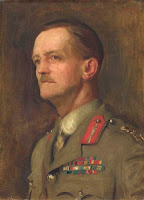We saw in January how the Sinai campaign ended with the Battle of Rafah and the retreat of the Ottomans behind their own frontier.
The advance across Sinai had been slow, as the British had to extend their railway line and a freshwater pipeline as they advanced. Initially, the British Commander in Egypt, Sir Archibald Murray, intended to proceed slowly, but after a meeting between the British and French, it was decided to advance on multiple fronts; Maude's advance on Baghdad was one; Murray was ordered to move on Gaza, while other advances were launched on the Western and Macedonian Fronts. The February Revolution in Russia had undercut the Eastern Front. By March, the rail line had reached Khan Yunis, and the Turks were entrenched south of Gaza.
 |
| Murray (Seven Pillars) |
 |
| Dobell |
The plan was to advance the rail line to the Wadi Ghazzeh, which cuts as a deep ravine a few miles south of Gaza. A network of ravines around the wadi made the land difficult to pass and the open, barren country south of the town gave a lack of cover and a clear field of fire to the Turkish defenders in their trenches. (See the map at bottom.)
 |
| Chetwode |
The defending forces were under the command of General Friedrich Kress von Kressenstein, the German Chief of Staff to Turkish Fourth Army Commander Djemal (Cemal) Pasha.
 |
| Kress von Kressenstein |
In the open, arid country, both sides were able to use aircraft to good effect; the British made bombing raids on Beersheba and a rail junction through February and March, and both sides flew reconnaissance missions.
 | ||||
| Bombing raid on Gaza | .. |
The British appear, in retrospect, to have underestimated not just the Turkish numbers but also their morale. Unlike the advance across Sinai, Gaza was clearly Ottoman territory, and in both the First and Second Battles of Gaza, the British would fail, at least in part due to a precipitate retreat.
More to come.







No comments:
Post a Comment